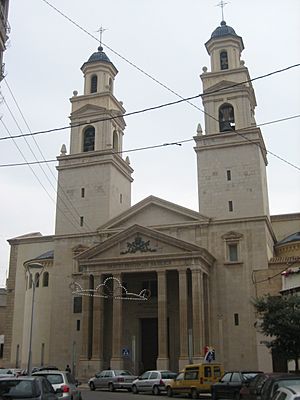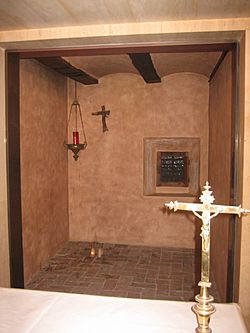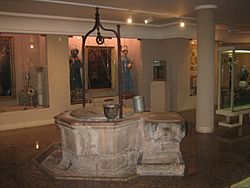Sanctuary of St. Paschal Baylon facts for kids
Quick facts for kids Sanctuary of St. Paschal Baylon |
|
|---|---|
 |
|
| 39°56′23″N 0°05′52″W / 39.9397°N 0.097683°W | |
| Location | Villareal |
| Country | Spain |
| Denomination | Catholic Church |
| History | |
| Dedication | Paschal Baylón |
| Architecture | |
| Style | Baroque architecture |
| Administration | |
| Diocese | Segorbe-Castellón |
The Sanctuary of St. Paschal Baylon is a famous church complex in the city of Villarreal, Spain. Many people call it El Sant, which means "The Saint." The sanctuary is a special place for pilgrimage, where people travel to honor Saint Paschal Baylon.
The complex includes a large church called a minor basilica, a Royal Chapel where the saint is buried, a museum, and a convent where Poor Clare nuns live.
The convent was first built in the 16th century. It became famous because Saint Paschal Baylon lived and died there. A beautiful Royal Chapel was built in the 17th century to hold his remains. This chapel was a masterpiece of Baroque style.
Sadly, during the Spanish Civil War in 1936, the original church and chapel were destroyed in a fire. A new church was built in its place. The new Royal Chapel was finished in 1992 and opened by King Juan Carlos I of Spain.
Today, you can still see historic parts of the monastery, like the cloister (a covered walkway) and the dining hall. The sanctuary also has two tall bell towers with a total of 84 bells. One of these is the largest swinging bell in the entire world!
Contents
History of the Sanctuary
How It All Began
The story of the sanctuary starts in the 16th century. In 1575, a group of Franciscan monks got permission to build a new convent in the area. They first stayed in a small chapel by the Mijares River.
Later, they moved to another small chapel on the edge of Villarreal. This chapel was built in 1571 to celebrate a Christian victory in the Battle of Lepanto. The monks started building their new convent there in 1578. They built it in a simple, plain style, which was part of their religious rules.
The Saint Who Made It Famous
The monastery became well-known because of a monk named Paschal Baylon. He came to live at the convent in 1589 and stayed there until he died in 1592.
Paschal was known for being very holy. After he died, people began to visit his tomb to pray. In the year he died, a well was dug in the cloister. Its water was said to be special, and it became known as the Pouet del Sant (Well of the Saint).
Because so many people believed he was a saint, the process to officially name him one began. King Philip II of Spain and his son Philip III supported this. In 1599, King Philip III and his wife visited the sanctuary to see the saint's tomb.
Later Events
Over the centuries, the sanctuary went through many changes. During a war in 1706, some buildings were damaged and had to be repaired.
In the 19th century, the monks had to leave for a time because of new laws in Spain. However, a group of Franciscan nuns from a nearby town moved in, and they still live there today.
In 1936, during the Spanish Civil War, the sanctuary was badly damaged by a fire. After the war ended, people donated money to rebuild it. The first stone of the new church was laid in 1942. The new Royal Chapel was completed much later, in 1992, just in time for the 400th anniversary of St. Paschal's death.
The Church Building
The current church stands on the site of the original one that was destroyed in the 1936 fire. The old church was built in a simple style with a single long hall, called a nave. It had several side chapels dedicated to different saints.
The new church is more modern and simple in its design. Above the main altar, there is a beautiful silver stand called a monstrance, held by two golden angels. This sculpture was made in 1952 by artist José Ortells.
Some artworks that were saved from the 1936 fire are now displayed in a museum room. This room is located on the first floor of the Royal Chapel and is called the Pouet del Sant museum.
The Royal Chapel
The First Chapel
After Paschal Baylon was officially recognized as a saint, the town of Villarreal decided to build a special chapel for his remains. King Charles II of Spain became the patron, or special protector, of the chapel. Because of this, it was called the "Royal Chapel."
The original chapel was a stunning example of Baroque art. The walls were decorated with special paintings and colorful ceramic tiles. The main attraction was a grand altarpiece made of gilded wood, which held a glass case with the saint's body.
Like the church, this beautiful chapel was destroyed in the 1936 fire. Some of the saint's relics (remains) were saved by local people.
The New Chapel
A new Royal Chapel was built and opened on May 17, 1992. It was designed by the artist Vicente Lloréns Poy.
The centerpiece of the new chapel is a silver tomb that shows St. Paschal lying down as if he were sleeping. The statue was made from 300 kilograms of silver. It was designed to look like the saint's body before the fire.
Behind the tomb is a huge altarpiece that is 14 meters high. It is covered in gold and features more than 50 figures. The main panel shows St. Paschal being glorified in heaven, surrounded by angels. Other panels show important people from the church's history, like popes and other saints. The coats of arms of King Charles II and King Juan Carlos I are also on the altarpiece, showing the chapel's royal protection.
The Famous Bells
On May 17, 1998, the sanctuary's amazing set of 84 bells was officially opened. The bells were a gift from a local businessman, José Gómez Mata. Together, they form one of the largest musical instruments in the world.
The bells are housed in the two towers of the basilica.
- The East Tower has 12 swinging bells. The largest one is named Santísimo Sacramento. It weighs 2,000 kilograms and is the largest swinging bell in the world.
- The West Tower has a carillon with 72 bells. A carillon is like a giant piano that is played with bells. The bells are played using a special keyboard, and they can create beautiful music.
Royal Visits

The sanctuary has been an important place for centuries, and many Spanish kings and queens have visited it.
King Juan Carlos I and Queen Sofia visited in 1976. King Juan Carlos I returned in 1992 to officially open the new Royal Chapel. He agreed to be its protector, just as King Charles II had been for the original chapel.
Other royals who have visited include:
- King Philip III in 1599.
- King Philip IV.
- King Charles III of Spain in the 18th century.
- Queen Isabella II of Spain in 1845.
- King Alfonso XIII in 1905.
Images for kids
See also
 In Spanish: Santuario de San Pascual Baylón para niños
In Spanish: Santuario de San Pascual Baylón para niños





